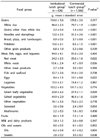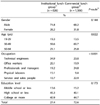2. Ministry of Health and Welfare, Korea Centers for Disease Control and Prevention. Korea Health Statistics 2014: Korea National Health and Nutrition Examination Survey (KNHANES VI-2). Sejong: Korea: Centers for Disease Control and Prevention;2015.
3. Statistics Korea. Annual report of employment: 2014 [Internet]. Daejeon: Statistics Korea;2015. cited 2016 March 18. Available from:
http://kosis.kr/ups/ups_01List.jsp.
4. Kim YS. The necessity and significance of reducing working hours [Internet]. Seoul: Lavour and Society Institute;2016. cited 2016 April 16. Available from:
http://klsi.org/content/8436.
5. Jang MR, Hong WS. Nutrition service need assessment for industrial employees. J Korean Diet Assoc. 2000; 6:26–32.
6. Chung SJ, Kang SH, Song SM, Ryu SH, Yoon J. Nutritional quality of Korean adults' comsumption of lunch prepared at home, commercial places and institutions: analysis of the data from the 2001 National Health and Nutrition Survey. Korean J Nutr. 2006; 39:841–849.
7. Bezerra IN, Sichieri R. Eating out of home and obesity: a Brazilian nationwide survey. Public Health Nutr. 2009; 12:2037–2043.

8. Naska A, Orfanos P, Trichopoulou A, May AM, Overvad K, Jakobsen MU, Tjønneland A, Halkjær J, Fagherazzi G, Clavel-Chapelon F, Boutron-Ruault MC, Rohrmann S, Hermann S, Steffen A, Haubrock J, Oikonomou E, Dilis V, Katsoulis M, Sacerdote C, Sieri S, Masala G, Tumino R, Mattiello A, Bueno-de-Mesquita HB, Skeie G, Engeset D, Barricarte A, Rodríguez L, Dorronsoro M, Sánchez MJ, Chirlaque MD, Agudo A, Manjer J, Wirfält E, Hellström V, Shungin D, Khaw KT, Wareham NJ, Spencer EA, Freisling H, Slimani N, Vergnaud AC, Mouw T, Romaguera D, Odysseos A, Peeters PH. Eating out, weight
and weight gain. A cross-sectional and prospective analysis in the context of the EPIC-PANACEA study. Int J Obes (Lond). 2011; 35:416–426.

9. Story M, Kaphingst KM, Robinson-O'Brien R, Glanz K. Creating healthy food and eating environments: policy and environmental approaches. Annu Rev Public Health. 2008; 29:253–272.

10. Sorensen G, Linnan L, Hunt MK. Worksite-based research and initiatives to increase fruit and vegetable consumption. Prev Med. 2004; 39:Suppl 2. S94–S100.

11. Lachat C, Nago E, Verstraeten R, Roberfroid D, Van Camp J, Kolsteren P. Eating out of home and its association with dietary intake: a systematic review of the evidence. Obes Rev. 2012; 13:329–346.

12. Naska A, Katsoulis M, Orfanos P, Lachat C, Gedrich K, Rodrigues SS, Freisling H, Kolsteren P, Engeset D, Lopes C, Elmadfa I, Wendt A, Knüppel S, Turrini A, Tumino R, Ocké MC, Sekula W, Nilsson LM, Key T, Trichopoulou A. HECTOR Consortium. Eating out is different from eating at home among individuals who occasionally eat out. A cross-sectional study among middle-aged adults from eleven European countries. Br J Nutr. 2015; 113:1951–1964.

13. Guthrie JF, Lin BH, Frazao E. Role of food prepared away from home in the American diet, 1977-78 versus 1994-96: changes and consequences. J Nutr Educ Behav. 2002; 34:140–150.

14. Kwon YS, Ju SY. Trends in nutrient intakes and consumption while eating-out among Korean adults based on Korea National Health and Nutrition Examination Survey (1998-2012) data. Nutr Res Pract. 2014; 8:670–678.

15. Kwon YS, Park YH, Choe JS, Yang YK. Investigation of variations in energy, macronutrients and sodium intake based on the places meals are provided: using the Korea National Health and Nutrition Examination Survey (KNHANES, 1998-2009). Nutr Res Pract. 2014; 8:81–93.

16. Wang H, Lee SR. Well-being orientation, consumer needs for lunch, and lunch behaviors. J Hum Life Sci. 2012; 15:99–119.
17. Vandevijvere S, Lachat C, Kolsteren P, Van Oyen H. Eating out of home in Belgium: current situation and policy implications. Br J Nutr. 2009; 102:921–928.

18. Roos E, Sarlio-Lähteenkorva S, Lallukka T. Having lunch at a staff canteen is associated with recommended food habits. Public Health Nutr. 2004; 7:53–61.

19. O'Dwyer NA, Gibney MJ, Burke SJ, McCarthy SN. The influence of eating location on nutrient intakes in Irish adults: implications for developing food-based dietary guidelines. Public Health Nutr. 2005; 8:258–265.
20. Raulio S, Roos E, Prättälä R. School and workplace meals promote healthy food habits. Public Health Nutr. 2010; 13:987–992.

21. Song YJ. The pattern of eating out among Korean adults from 4th Korea National Health and Nutrition Examination Survey. Public Health Wkly Rep. 2010; 3:597–602.
22. Ministry of Health and Welfare (KR). The Korean Nutrition Society. Dietary Reference Intakes for Koreans 2015. Sejong: Ministry of Health and Welfare;2016.
23. Willett WC, Stampfer MJ. Current evidence on healthy eating. Annu Rev Public Health. 2013; 34:77–95.

24. Guthrie HA, Scheer JC. Validity of a dietary score for assessing nutrient adequacy. J Am Diet Assoc. 1981; 78:240–245.

25. Vlismas K, Stavrinos V, Panagiotakos DB. Socio-economic status, dietary habits and health-related outcomes in various parts of the world: a review. Cent Eur J Public Health. 2009; 17:55–63.

26. Choi MK, Kim JM, Kim JG. A study on the dietary habit and health of office workers in Seoul. Korean J Food Cult. 2003; 18:45–55.
27. Korean Health Industry Development Institute. National Food & Nutrition Statistics: based on 2012 Korea National Health and Nutrition Examination Survey. Cheongju: Korean Health Industry Development Institute;2014.
28. Seo JS, Cho SH. Rice-based traditional meal and prevention of chronic diseases. Food Ind Nut. 2008; 13:27–33.
29. Kim DW, Shim JE, Paik HY, Song WO, Joung H. Nutritional intake of Korean population before and after adjusting for within-individual variations: 2001 Korean National Health and Nutrition Survey Data. Nutr Res Pract. 2011; 5:266–274.

30. Kim MS, Kweon DC, Bae YJ. Evaluation of nutrient and food intake status, and dietary quality according to abdominal obesity based on waist circumference in Korean adults: based on 2010-2012 Korean National Health and Nutrition Examination Survey. J Nutr Health. 2014; 47:403–415.

31. Song DY, Park JE, Shim JE, Lee JE. Trends in the major dish groups and food groups contributing to sodium intake in the Korea National Health and Nutrition Examination Survey 1998-2010. Korean J Nutr. 2013; 46:72–85.

32. Lee YK. A Study on a Scheme to Reduce Sodium Intake. Seoul: Korea Health Promotion Foundation;2006.
33. Shin EK, Lee HJ, Jun SY, Park EJ, Jung YY, Ahn MY, Lee YK. Development and evaluation of nutrition education program for sodium reduction in food service operations. Korean J Community Nutr. 2008; 13:216–227.
34. Lee YN, Kim CI, Shin HH, Nam JW, Lee JY, Kim DH, Lee HJ, Koh EM, Yon MY. Project to Reduce Sodium Intake - Trends of Technics for Reducing Sodium Contents in Processed Foods and Development of Guidelines. Cheongwon: Korea Health Industy Development Institute;2012.
35. National Center for Chronic Disease Prevention and Health Promotion. Division for Heart Disease and Stroke Prevention (US). Under pressure: prevention strategies for sodium reduction in worksites [Internet]. Atlanta(GA): Centers for Chronic Disease Prevention;2012. cited 2016 June 6. Available from:
http://www.cdc.gov/salt/pdfs/sodium_reduction_worksites.pdf.
36. Lederer A, Curtis CJ, Silver LD, Angell SY. Toward a healthier city: nutrition standards for New York City government. Am J Prev Med. 2014; 46:423–428.
37. Kwon JH, Shim JE, Park MK, Paik HY. Evaluation of fruits and vegetables intake for prevention of chronic disease in Korean adults aged 30 years and over: using the third Korea National Health and Nutrition Examination Survey(KNHANES III), 2005. Korean J Nutr. 2009; 42:146–157.

38. Ministry of Health and Welfare (KR). National Health Plan 2020. Seoul: Ministry of Health and Welfare;2011.
39. Min C, Noh H, Kang YS, Sim HJ, Baik HW, Song WO, Yoon J, Park YH, Joung H. Skipping breakfast is associated with diet quality and metabolic syndrome risk factors of adults. Nutr Res Pract. 2011; 5:455–463.

40. Baek Y, Joung H, Shin S. The association between vegetable intake and marital status in Korean adults aged 30 years and over: based on the 2007~2010 Korea
National Health and Nutrition Examination Survey. J Nutr Health. 2015; 48:192–198.

41. Lassen A, Thorsen AV, Trolle E, Elsig M, Ovesen L. Successful strategies to increase the consumption of fruits and vegetables: results from the Danish '6 a day' Work-site Canteen Model Study. Public Health Nutr. 2004; 7:263–270.

42. Lachat CK, Verstraeten R, De Meulenaer B, Menten J, Huybregts LF, Van Camp J, Roberfroid D, Kolsteren PW. Availability of free fruits and vegetables at canteen lunch improves lunch and daily nutritional profiles: a randomised controlled trial. Br J Nutr. 2009; 102:1030–1037.

43. Shim JE, Paik HY, Moon HK, Kim YO. Comparative analysis and evaluation of dietary intakes of Koreans by age groups: (5) meal patterns. J Korean Home Econ Assoc. 2004; 42:169–185.
44. Moon HK, Kim EG. Nutrient and food intake of Koreans by the economic status and meal pattern using 1998 Korean National Health Examination Nutrition Survey. Korean J Nutr. 2004; 37:236–250.












 PDF
PDF ePub
ePub Citation
Citation Print
Print






 XML Download
XML Download